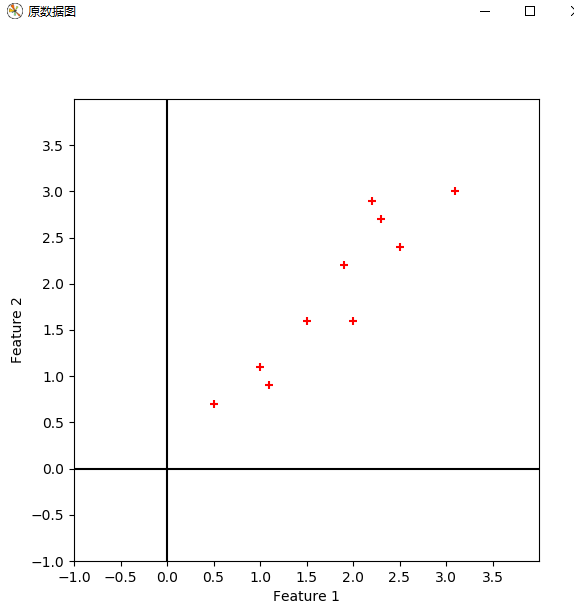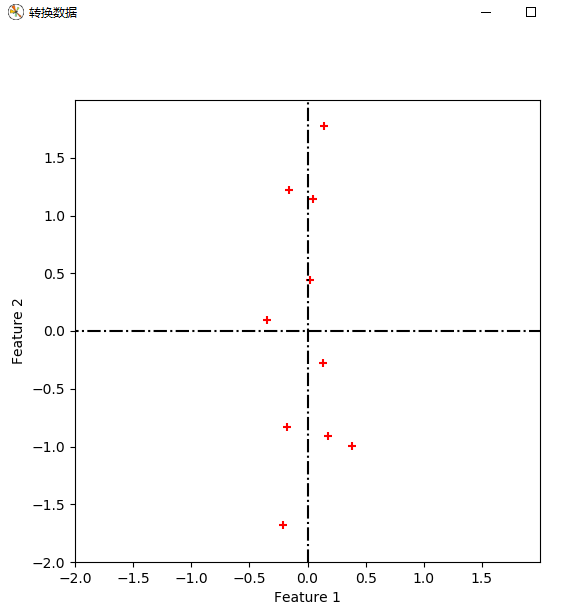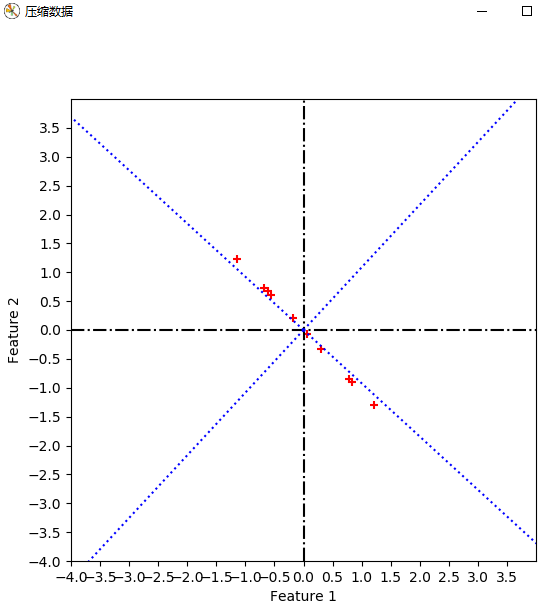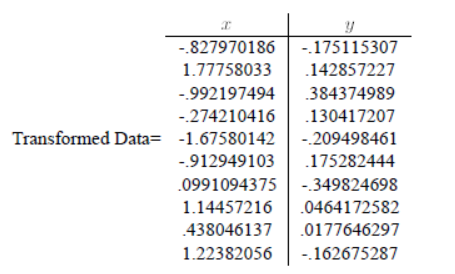数学原理参考:https://blog.csdn.net/aiaiai010101/article/details/72744713
实现过程参考:https://www.cnblogs.com/eczhou/p/5435425.html
两篇博文都写的透彻明白。
自己用python实现了一下,有几点疑问,主要是因为对基变换和坐标变换理解不深。
先附上代码和实验结果:
code:

from numpy import * import numpy as np import matplotlib.pyplot as plt from scipy.io import loadmat cx = mat([[2.5, 2.4], [0.5, 0.7], [2.2, 2.9], [1.9, 2.2], [3.1, 3.0], [2.3, 2.7], [2, 1.6], [1, 1.1], [1.5, 1.6], [1.1, 0.9]]) # print(cx.shape) sz = cx.shape m = sz[0] n = sz[1] # 显示原数据 def plot_oridata( cx ): plt.figure(num='原数据图', figsize=(6, 6)) plt.xlabel('Feature 1') plt.ylabel('Feature 2') plt.xlim((-1, 4)) plt.ylim((-1, 4)) new_ticks = np.arange(-1, 4, 0.5) plt.xticks(new_ticks) plt.yticks(new_ticks) plt.scatter(cx[:, 0].tolist(), cx[:, 1].tolist(), c='r', marker='+') plt.plot([0, 0], [-1, 4], 'k-') plt.plot([-1, 4], [0, 0], 'k-') plt.show() return #求协方差矩阵 def get_covMat( cx ): print('+++++++++++++ 求协方差矩阵 +++++++++++++++') # 零均值化 ecol = np.mean(cx, axis=0) cx1 = (cx[:, 0]) - ecol[0, 0] cx2 = cx[:, 1] - ecol[0, 1] Mcx = np.column_stack((cx1, cx2)) Covx = np.transpose(Mcx)*Mcx/(m-1) # print(Covx) return Covx, Mcx #计算特征值和特征向量 def get_eign(Covx, k): eVals, eVecs = np.linalg.eig(Covx) # print(eVals) # print(eVecs, ' ', eVecs.shape) sorted_indices = np.argsort(eVals) topk_evecs = eVecs[:, sorted_indices[:-k-1:-1]] # print(topk_evecs) plt.figure(num='特征向量', figsize=(6, 6)) plt.xlabel('Feature 1') plt.ylabel('Feature 2') plt.xlim((-4, 4)) plt.ylim((-4, 4)) new_ticks = np.arange(-4, 4, 1) plt.xticks(new_ticks) plt.yticks(new_ticks) plt.scatter(cx[:, 0].tolist(), cx[:, 1].tolist(), c='r', marker='+') plt.plot([0, 0], [-4, 4], 'k-.') plt.plot([-4, 4], [0, 0], 'k-.') # print(eVecs[0, 0], eVecs[1, 0]) # print(eVecs) plt.plot([0, eVecs[0, 0] * 6], [0, eVecs[1, 0] * 6], 'b:') plt.plot([0, eVecs[0, 1] * 6], [0, eVecs[1, 1] * 6], 'b:') plt.plot([0, eVecs[0, 0] * -6], [0, eVecs[1, 0] * -6], 'b:') plt.plot([0, eVecs[0, 1] * -6], [0, eVecs[1, 1] * -6], 'b:') plt.show() return eVecs, topk_evecs #转换数据 def transform_data(eVecs, Mcx): print("------------------转换数据---------------------") tran_data = Mcx * eVecs plt.figure(num='转换数据', figsize=(6, 6)) plt.xlabel('Feature 1') plt.ylabel('Feature 2') plt.xlim((-2, 2)) plt.ylim((-2, 2)) new_ticks = np.arange(-2, 2, 0.5) plt.xticks(new_ticks) plt.yticks(new_ticks) plt.scatter(tran_data[:, 0].tolist(), tran_data[:, 1].tolist(), c='r', marker='+')#哪一维对应x,哪一维对应y plt.plot([0, 0], [-4, 4], 'k-.') plt.plot([-4, 4], [0, 0], 'k-.') # print(eVecs[0, 0], eVecs[1, 0]) # print(eVecs) plt.show() return #压缩数据 def compress_data(Mcx, topkevecs, eVecs): print("------------------压缩数据---------------------") comdata = Mcx * topkevecs c1 = np.zeros((10, 1), dtype=int) comdata1 = np.column_stack((c1, comdata)) comdata2 = comdata1 * eVecs plt.figure(num='压缩数据', figsize=(6, 6)) plt.xlabel('Feature 1') plt.ylabel('Feature 2') plt.xlim((-4, 4)) plt.ylim((-4, 4)) new_ticks = np.arange(-4, 4, 0.5) plt.xticks(new_ticks) plt.yticks(new_ticks) plt.scatter(comdata2[:, 0].tolist(), comdata2[:, 1].tolist(), c='r', marker='+') # 哪一维对应x,哪一维对应y plt.plot([0, 0], [-4, 4], 'k-.') plt.plot([-4, 4], [0, 0], 'k-.') plt.plot([0, eVecs[0, 0] * 6], [0, eVecs[1, 0] * 6], 'b:') plt.plot([0, eVecs[0, 1] * 6], [0, eVecs[1, 1] * 6], 'b:') plt.plot([0, eVecs[0, 0] * -6], [0, eVecs[1, 0] * -6], 'b:') plt.plot([0, eVecs[0, 1] * -6], [0, eVecs[1, 1] * -6], 'b:') # print(eVecs[0, 0], eVecs[1, 0]) # print(eVecs) plt.show() return plot_oridata(cx) Covx, Mcx = get_covMat(cx) eVecs, topk_evecs = get_eign(Covx, 1) transform_data(eVecs, Mcx) compress_data(Mcx, topk_evecs, eVecs) print('end')
初学python,代码肯定很啰嗦,并且很丑。
实验结果:




疑问1:对数据进行特征向量为基的转换时,公式如下。我得到的坐标是以原坐标系为参考的,那么哪一维对应x,哪一维对应y,如果我将特征向量按照特征值降序的顺序重新排列,是否有影响呢?
得到的坐标是新坐标系下的。根据转换向量对应。

疑问2:取最大特征值对应的特征向量为基时,对数据进行降维,此时我得到的一维坐标是以这个特征向量为参考的吗?此时我应该如何在原坐标系show出这些数据?
我的代码中,取第一维为0,第二维为得到的坐标,以此再进行以此疑问1中的二维基转换,得到坐标,并且plot。不太理解道理。
对一维坐标,分别对两个坐标轴投影即可得到新坐标系下的两个坐标。
